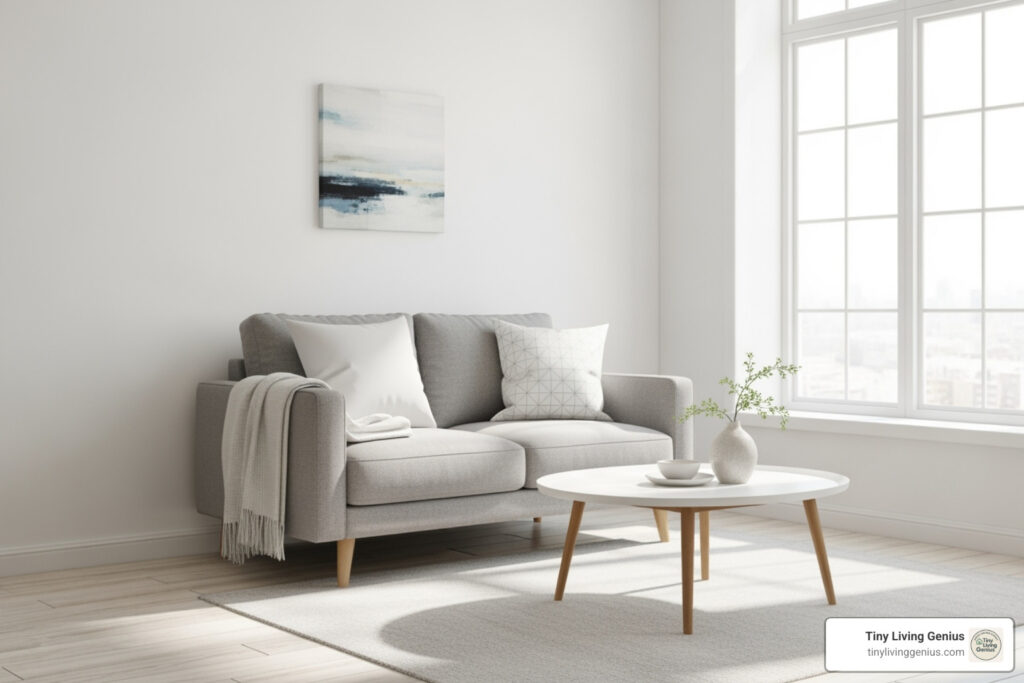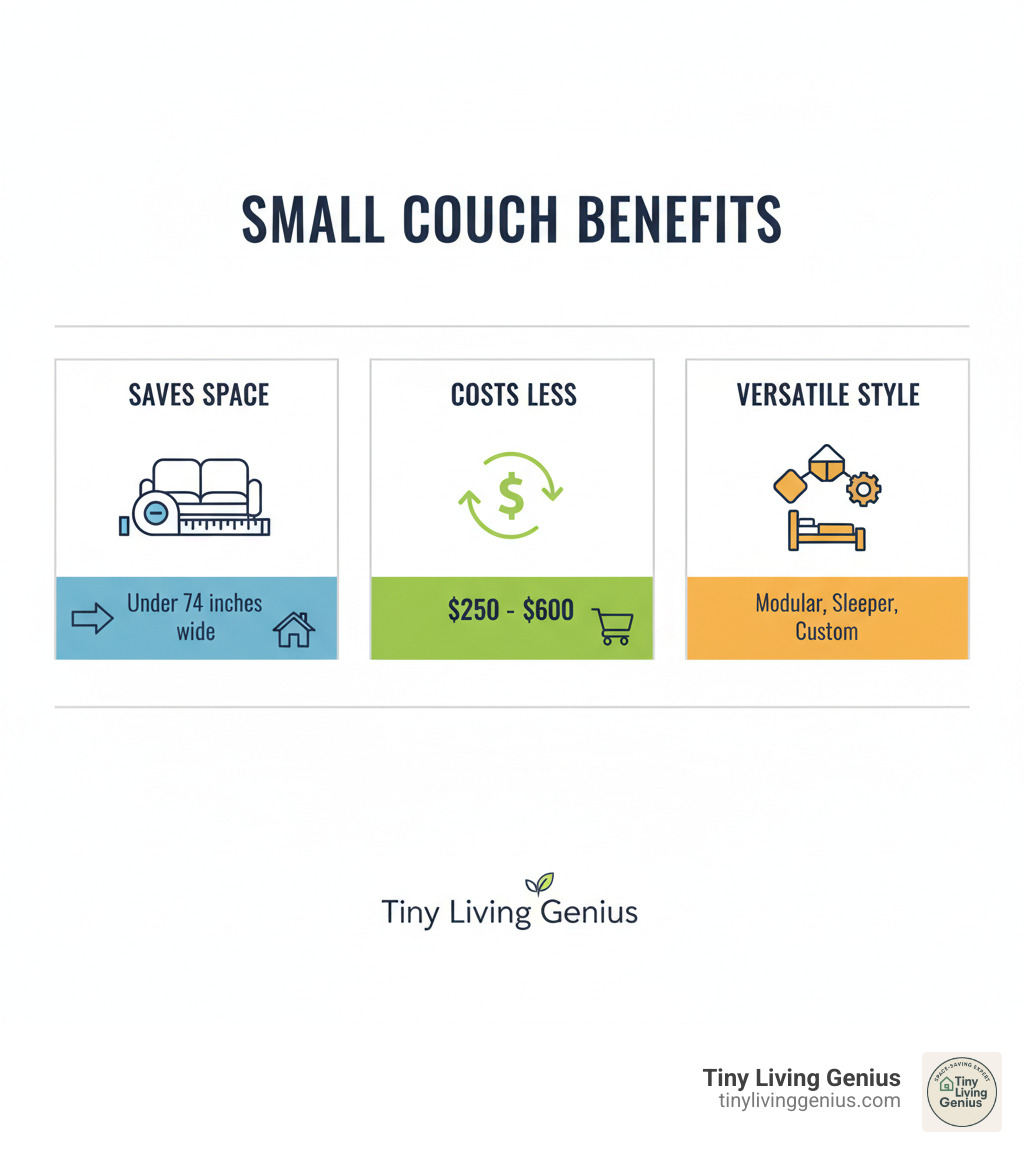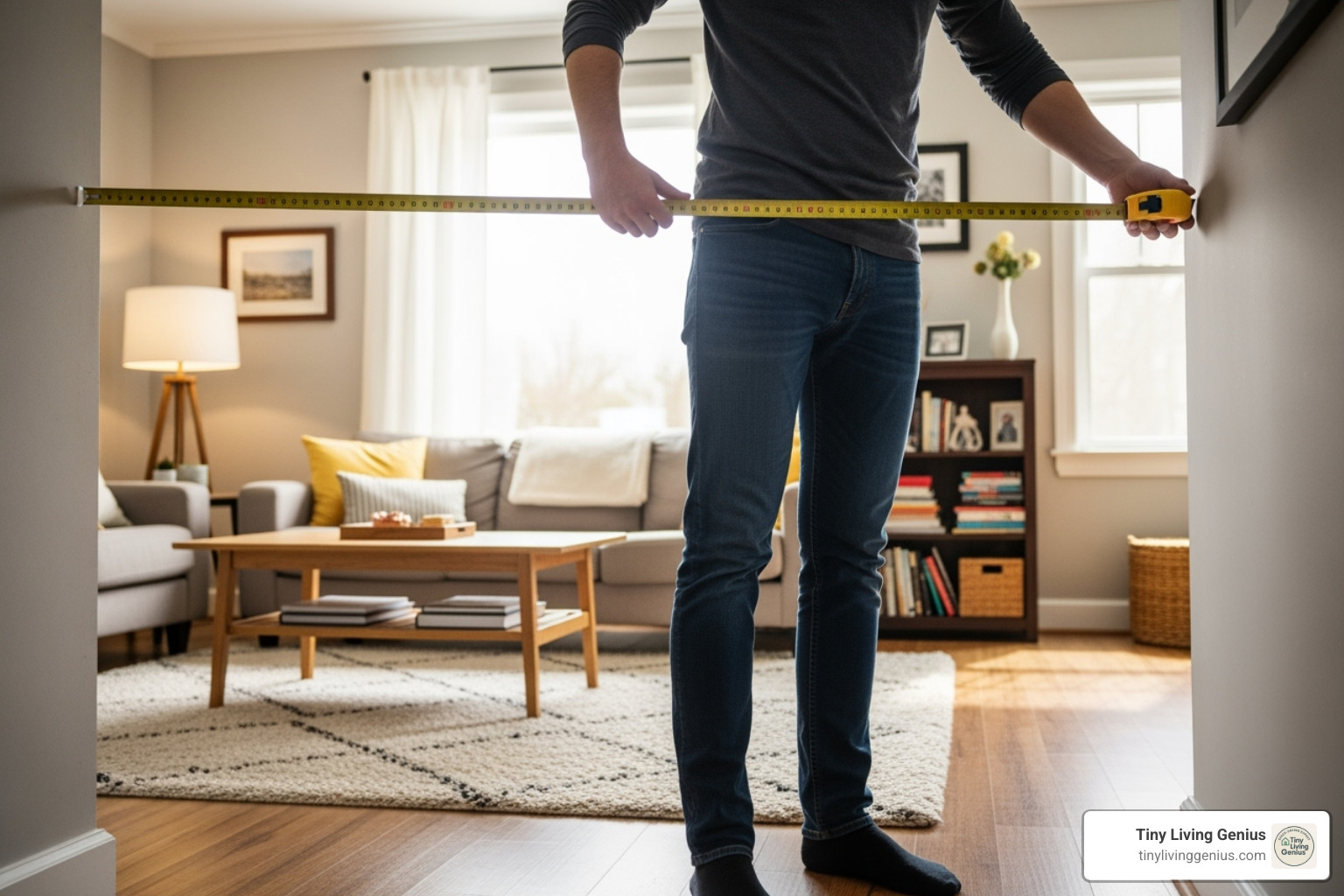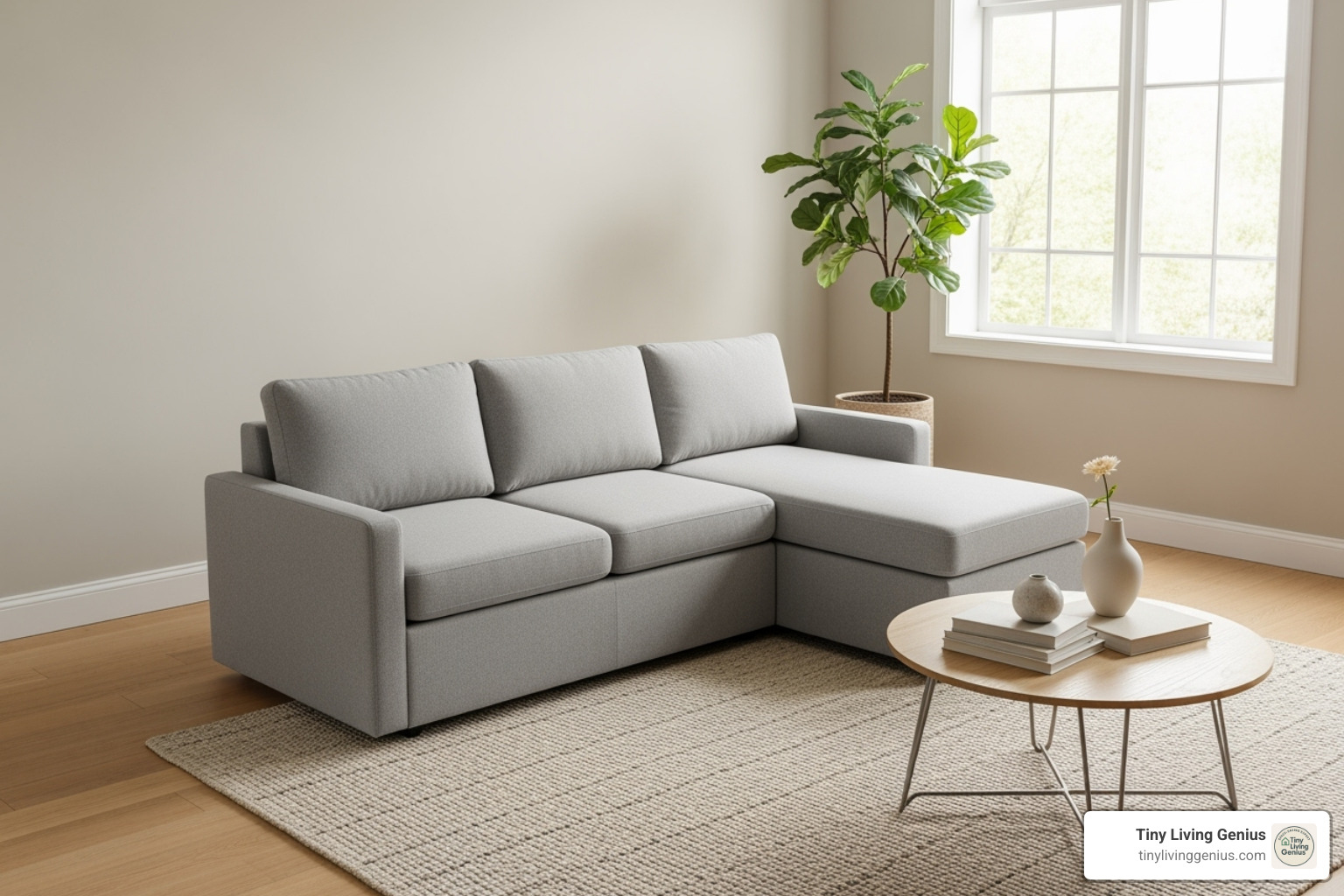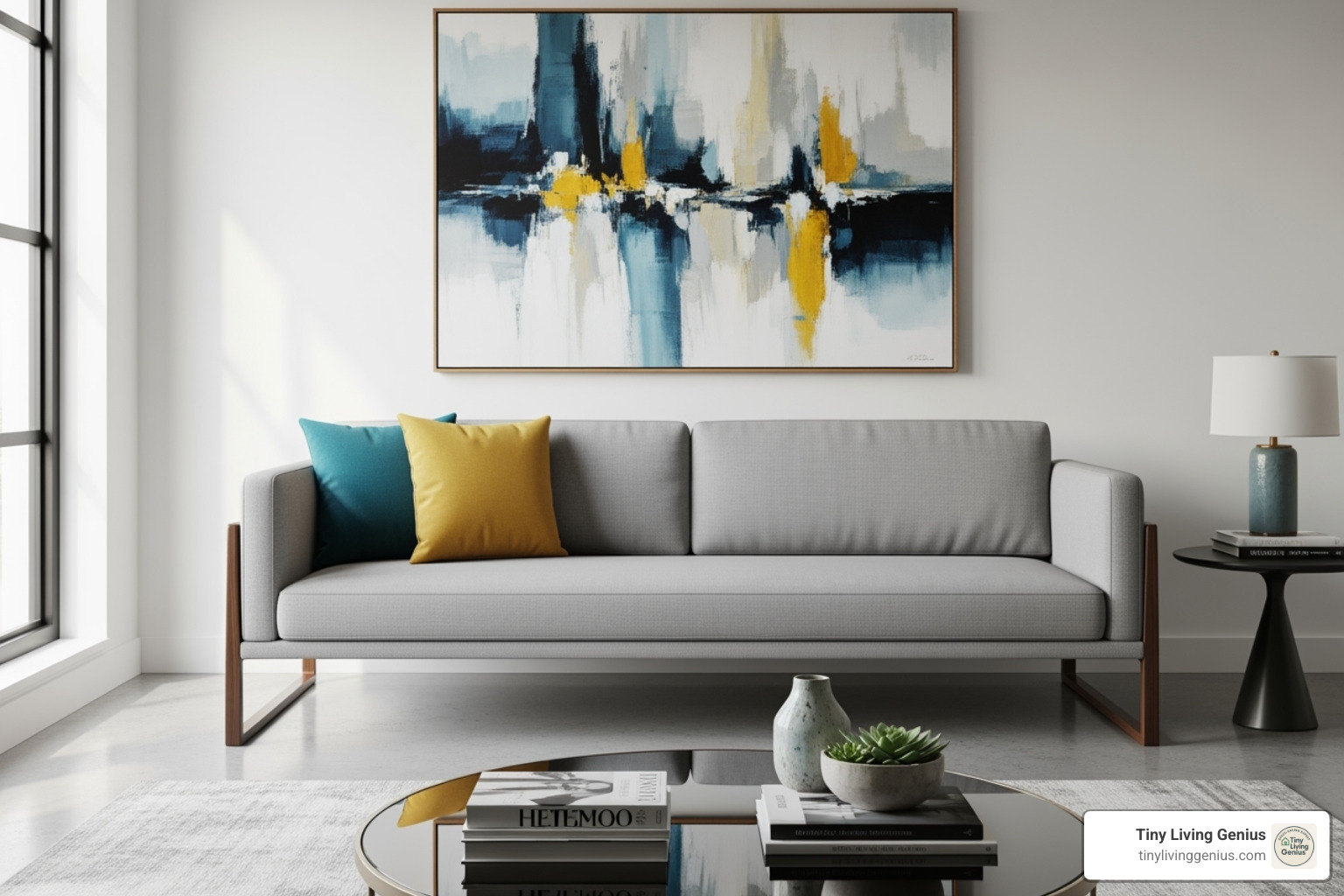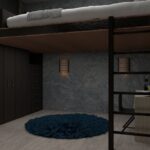Small couches: Ultimate 3 for Tiny Living
Why Small Couches Are Essential for Compact Living
Small couches are designed to maximize comfort and style in compact spaces, typically measuring 74 inches or less in width. Here’s what you need to know:
Quick Guide to Small Couches:
| Type | Typical Width | Best For |
|---|---|---|
| Loveseat | 52-64 inches | Apartments, small rooms |
| Compact Sofa | 70-74 inches | Small living rooms |
| Sleeper Sofa | 70-88 inches | Multi-functional spaces |
| Modular | Customizable | Flexible layouts |
Key Features to Look For:
- Width under 74 inches (72 inches is the sweet spot)
- Seat depth of 21-24 inches
- Slim arms and raised legs
- Durable, easy-to-clean upholstery
- Multi-functional design (storage, sleeper options)
Finding the right couch for a small space isn’t just about squeezing something in—it’s about making smart choices that improve your entire living experience. The wrong sofa can overwhelm your room, block pathways, and make your apartment feel even smaller. The right one? It transforms your space into a functional, inviting home.
The challenge is real. You need seating that’s comfortable enough for movie marathons but compact enough to leave breathing room. You want style without sacrificing precious square footage. And ideally, you’re not spending a fortune—because while full-size couches can cost $1,000 or more, most small space options run under $900, with quality picks available between $250 and $600.
This guide breaks down everything you need to know about choosing a small couch that actually works for your space. We’ll cover sizing guidelines, different types of compact sofas, must-have features, and design tricks that make your room feel larger. You’ll learn which materials hold up best, how to measure correctly, and what to prioritize based on your specific needs.
As Ramy Saber, founder of Tiny Living Genius and a Civil Engineer specializing in small-space solutions, I’ve spent years helping people maximize functionality in compact homes, including selecting the perfect small couches for apartments and studios. Whether you’re furnishing your first apartment or downsizing to a cozier space, these insights will help you make a confident choice.
Important small couches terms:
Sizing It Up: Finding the Perfect Dimensions
Here’s the truth about shopping for a small couch: you can fall head-over-heels for a beautiful sofa online, but if it doesn’t fit through your door or overwhelms your living room, it’s going back. And trust me, wrestling with a couch that’s three inches too wide for your hallway is nobody’s idea of a good time.
The secret to finding the perfect small couch isn’t just about knowing where it’ll sit—it’s about understanding your entire space, from the room layout to every doorway it needs to squeeze through.
Practical Tips for Measuring and Choosing Furniture for Compact Living Areas
Before you start browsing couches (the fun part), let’s talk about the not-so-fun but absolutely essential part: measuring. Grab a tape measure, your phone’s notes app, and maybe some painter’s tape if you’re the visual type.
Start with your room’s layout. Interior designer Shivani Vyas puts it perfectly: “Start by measuring your room’s layout and architectural elements, including (but not limited to) beams, windows, fireplaces, and doors.” These aren’t just decorative features—they’re the fixed elements that determine where your small couch can actually go. Map out your entire space, paying special attention to traffic flow. You don’t want your gorgeous new sofa blocking the path to your kitchen.
Next, measure the journey your couch will take to get home. This is the step most people skip, and it’s the one that causes the most headaches. Measure every doorway, hallway, and stairwell your couch needs to steer. Don’t forget about tight corners or low ceilings. Write down the width and height of each passage. A beautiful couch sitting in your building’s lobby because it won’t fit up the stairs isn’t doing anyone any good.
Now for the magic number: 74 inches or less. That’s the ideal maximum width for most small couches in compact spaces. The real sweet spot? Around 72 inches wide. This width gives you comfortable seating without making your room feel like a furniture showroom. It leaves breathing room for walking, side tables, and that general sense of spaciousness that makes small spaces livable.
Don’t forget about seat depth. While everyone focuses on width, depth matters just as much for comfort. Most small couches have a seat depth between 21 and 24 inches. This range works well for most people, offering good back support without eating up floor space. If you’re taller or love to curl up with your feet on the couch, you might want something deeper than 24 inches—just remember that every extra inch of depth takes away from your walking space.
The beauty of careful measuring? You’ll shop with confidence instead of crossing your fingers and hoping for the best. Even a couch that’s just a few inches too big can transform a cozy room into a cramped one.
Want more guidance on choosing furniture that actually fits your compact home? Our Ultimate Guide to Small Apartment Furniture: Smart Solutions for Tiny Living covers everything from sofas to storage solutions.
Types of Small Couches: Which Style Suits Your Space?
Now that you’ve got your measurements sorted, let’s dive into the exciting part—finding the small couch that’s perfect for your life. The good news? There’s a surprisingly diverse world of compact seating options out there, each with its own superpowers. Whether you’re a minimalist who loves clean lines, a frequent host who needs flexibility, or someone who wants their furniture to work double-duty, there’s a style that’ll make your small space feel just right.
The Cozy Loveseat
If we’re talking about classic small couches, the loveseat deserves a standing ovation. This is the furniture piece that practically invented apartment living. It’s intimate, efficient, and honestly? Just plain charming.
The loveseat offers comfortable seating for two people, which makes it ideal whether you’re sharing your space with a partner, flying solo, or just need extra seating in a larger room. Most loveseats measure between 52 and 64 inches wide and about 30-40 inches deep. That compact footprint is exactly why they fit so beautifully into tight corners or against smaller walls where a full-size sofa would be laughably impossible.
There’s a reason these are sometimes called “apartment sofas.” They provide all the essential seating you need without bullying the rest of your room. You’ll actually have space left over for a coffee table, a bookshelf, or—imagine this—just room to walk around freely. We’ve seen some fantastic examples like the IKEA MORABO Loveseat, which people love for its soft upholstery and solid frame, or the Allmodern Rae Loveseat for those wanting something more contemporary.
If you’re after traditional, reliable seating that won’t overwhelm your space, a loveseat is your friend. For more insights on compact seating solutions, check out our guide on Couches for Small Spaces.
The Versatile Modular Sofa
Here’s where things get really interesting. If you love the idea of furniture that adapts to your life (instead of the other way around), modular sofas are about to become your new obsession. Think of them as furniture Lego blocks for grown-ups.
The magic of modular sofas lies in their custom configurations. Need an L-shape for movie night? Done. Want to split it into two separate seats for better conversation flow? Easy peasy. This flexibility is absolutely transformative for small or oddly shaped rooms where traditional furniture just doesn’t cooperate.
But here’s what really sold us on modular small couches: they’re built for real life. Moving to a new apartment? No problem. As one furniture expert put it, modular sofas “can be as large or small as you need them to be,” and their adaptability means “you can make changes later on if you upgrade your space.” They break down into smaller, manageable pieces, so you won’t be stuck trying to wrestle a giant sofa through a narrow doorway at 9 PM on moving day.
Got unexpected guests coming over? You can rearrange your modular sofa to add extra seating or open up floor space for mingling. It’s like having a furniture transformer right in your living room. Even better, you can start with just a simple two-seater and add sections as your needs evolve. Your sofa can actually grow with you instead of becoming obsolete after your next move.
Take the Anabei Modular Performance 2-Seater, which comes in at just 68.5 inches wide—all the perks of a sectional in a truly compact form. The Linsy Home 3 Seat Couch (Rubik III) is another clever option that you can split up or arrange however you like. Even IKEA’s FINNALA Loveseat can be adapted by removing side arms to add more sections. The possibilities really are endless, and that’s exactly what makes modular sofas so brilliant for compact living.
The Functional Sleeper Sofa
When you’re working with limited square footage, furniture that does double-duty isn’t just nice to have—it’s essential. Enter the sleeper sofa, the multitasking champion of small couches.
A sleeper sofa gives you comfortable seating during the day and transforms into a proper bed at night. For studio apartments or homes without a dedicated guest room, this is genuinely life-changing. At Tiny Living Genius, we’re big believers that furniture should work harder, not take up more space. Why settle for something that only does one job when it can do two?
The guest accommodation angle alone makes sleeper sofas worth considering. No more awkward air mattresses that deflate at 3 AM! Your guests get a real, comfortable sleeping surface, and you don’t need to sacrifice an entire room to make it happen. During the day, your living room looks like, well, a living room. At night, it becomes a cozy guest suite. That’s the kind of maximizing functionality that compact living is all about.
For studio apartments, sleeper sofas are practically non-negotiable. They help define your living area during waking hours and provide your sleeping space at night, making every inch count. Even the smallest sleeper sofas give you plenty of room to move around when they’re in couch mode.
The Pottery Barn Cameron Slope Arm Sleeper Sofa is a popular choice for its classic style and genuine comfort. If you’re after something with more personality, the Hernest’s Modern Velvet Upholstered Sofa Bed Sleeper brings style and function together beautifully. And for those who want easy conversion without sacrificing aesthetics, the Joybird Briar Sleeper Sofa offers slender arms and plush cushioning in a compact package.
Want to dive deeper into sleep solutions for small spaces? Our guide on Small Double Sofa Bed has you covered.
Key Features to Look For in a Small Couch
Finding the perfect small couch isn’t just about dimensions—it’s about the thoughtful design details that make a compact sofa work beautifully in your space. The right features can transform a cramped room into an airy, functional haven.
Space-Saving Design: Slim Arms, Raised Legs, and Visual Weight
Let’s talk about visual tricks that make your small couch punch above its weight class. Traditional couches with chunky, rolled arms might look cozy, but they’re space hogs in disguise. Instead, look for slim, straight arms or even armless designs. These streamlined profiles shave precious inches off the overall width without sacrificing comfort. You’d be surprised how much more open a room feels when your sofa isn’t hogging every available inch.
Here’s a design secret that interior designers swear by: raised legs. When you can see the floor beneath your small couch, something magical happens. Light flows underneath, your eye travels across the room uninterrupted, and suddenly your space feels larger. As experts point out, this simple feature “creates visual flow and an open, airy feeling” that’s worth its weight in gold for compact living.
Think about visual weight too. A bulky, overstuffed couch can dominate a small room like an elephant in a china shop. Instead, choose designs with sleek lines, minimalist profiles, and lighter colors. These sofas provide all the comfort you need without that overwhelming presence that makes your living room feel like a furniture showroom.
Multi-functionality and Built-in Storage
In compact living, furniture that does double duty isn’t just nice to have—it’s essential. We’ve already explored sleeper sofas, but multi-functional small couches extends far beyond that. Some modular designs include ottomans that transform into extra seating, footrests, or even impromptu coffee tables. Others come with built-in side tables or charging ports, keeping your devices powered without cluttering your space with extra furniture.
Built-in storage is where things get really exciting. A small couch with hidden compartments under the seat cushions or within an accompanying ottoman is like finding extra closet space you didn’t know you had. Tuck away throw blankets for movie night, stash books you’re currently reading, or hide those remotes that always seem to disappear. This kind of storage keeps your living area tidy and clutter-free, which is absolutely crucial for maintaining that open, breathable feel in a compact space.
Bench Cushions
Interior designer Jess Klein shares a brilliant tip that many people overlook: “When I’m sourcing a small sofa, I like to look at the bench cushion options first, as that style allows for more people to sit. Sometimes, the division that separates the cushions decreases the actual sitting space.”
Think about it—those gaps between individual seat cushions aren’t just visual breaks, they’re actual lost seating space. A single, continuous bench cushion eliminates these divisions, making your small couch feel more generous and accommodating. It’s a small detail that makes a surprisingly big difference when you’re trying to squeeze one more friend onto the sofa for game night.
Choosing the Right Upholstery for Small Couches
The fabric covering your small couch does more than just look pretty—it determines how well your sofa holds up to real life. As Gifty Walker, an expert in merchandising, wisely points out, you need to consider “who is using the furniture and how?” when choosing upholstery. This simple question should guide your entire decision.
Performance fabrics are the superheroes of the upholstery world. These engineered materials resist stains, fading, and wear like champions. They’re typically synthetic blends that you can wipe clean with minimal fuss, making them ideal for busy households where spills are a fact of life rather than a rare disaster.
Leather deserves special mention for its incredible durability. One of our team members has a 15-year-old leather loveseat that survived two dogs and a cat—and it still looks new! Leather develops a beautiful patina over time, becoming even more attractive as it ages. It’s generally easy to clean and can handle whatever life throws at it.
For those who love luxury, velvet, linen, and chenille offer that sophisticated, high-end feel that makes your small couch the star of the room. These materials make a strong style statement and feel wonderful to sink into. However, they come with a caveat—they’re “more difficult to clean,” as experts note. If your household isn’t prone to spills and messes, these fabrics can be absolutely stunning choices.
Pet owners should look for tightly woven fabrics or leather that resist snags and are easy to de-fur. Performance fabrics often work beautifully here, standing up to claws and paws without showing excessive wear.
Families with kids will appreciate the magic of washable slipcovers. The IKEA Uppland Sofa, for example, features removable covers that you can toss in the washing machine. Juice spill? Marker mishap? No problem—just wash it away. This kind of practical design lets you have nice things without constant stress about keeping them pristine.
For more creative ways to choose furniture that works harder for you, explore our Creative Ideas for Small Space Furniture: Maximizing Functionality.
Frame and Construction: Built to Last
A gorgeous exterior means nothing if your small couch falls apart in two years. The frame is the skeleton that holds everything together, and cutting corners here is a mistake you’ll regret.
Solid hardwood frames are the gold standard for a reason. Couches built with oak, maple, or birch frames are robust warriors that withstand years of sitting, flopping, and occasional jumping (we won’t tell). These frames provide the stability and support that keep your sofa comfortable and sturdy for the long haul.
Even better than standard hardwood is kiln-dried wood. The kiln-drying process removes moisture from the lumber, preventing warping, cracking, and splitting over time. This extra step makes the frame more stable and dramatically extends the life of your small couch. It’s the difference between furniture that lasts five years and furniture that lasts twenty.
Metal frames show up frequently in sleeper sofas, where they provide the strength needed for pull-out mechanisms. When combined with solid hardwood components, metal frames can be extremely durable. They handle the mechanical stress of converting from sofa to bed and back again without complaint.
Here’s what to avoid: MDF (medium-density fiberboard) or particleboard frames. Yes, they lower the initial price tag, but they’re significantly weaker than solid wood. These materials break down over time, leading to a saggy, unstable couch that wobbles and creaks. What seemed like a bargain becomes a headache—and an expense—when you need to replace it years earlier than you should.
Investing in quality construction means your small couch remains comfortable, supportive, and beautiful for years to come. In compact living, where every piece of furniture matters more, choosing durability over a lower price tag is always the smarter move.
Design Tricks to Make Your Room Feel Larger
Here’s the wonderful thing about small spaces: with a few smart design tricks, you can make your room feel significantly larger than its actual square footage. Once you’ve found the perfect small couch, the way you style and arrange your space becomes just as important as the furniture itself.
Let’s start with furniture placement. You might assume that pushing your small couch against the wall is the only option, but floating it slightly away from the wall can actually create a surprising sense of depth. This little gap allows light and air to flow around the piece, making the entire room feel less cramped. If your layout allows, try positioning furniture at subtle angles to create more interesting sight lines and break up the boxy feel that small rooms can sometimes have.
Color is your secret weapon. Light, neutral hues are absolute game-changers for compact spaces. Think warm sand tones, soft beiges, gentle creams, or earthy terra cotta shades for your small couch and surrounding decor. These colors reflect natural light beautifully, making walls feel like they’re receding rather than closing in. As our design team at Tiny Living Genius always emphasizes, thoughtful color choices don’t just brighten a room—they fundamentally transform how spacious it feels.
Mirrors work magic. Strategically placing a large mirror opposite a window can practically double your perceived square footage. Mirrors bounce light around the room, creating brightness and the illusion of depth. It’s like adding an extra window without any construction work!
Accept minimalism. In small spaces, every item you display matters. Keep surfaces relatively clear and avoid over-accessorizing. This doesn’t mean your space has to feel sterile—just intentional. Each piece should either serve a purpose or bring you genuine joy. A cluttered room will always feel smaller than it actually is, no matter how carefully you’ve chosen your small couch.
Think vertically. Your walls are valuable real estate! Use floating shelves, wall-mounted storage, or tall, narrow artwork to draw the eye upward. This simple trick makes ceilings feel higher and rooms more expansive. Instead of spreading things out horizontally (which eats up precious floor space), go up.
Define zones with area rugs. If you’re working with an open-plan layout, a well-chosen area rug can beautifully define your living room zone around your small couch without physical barriers. Just make sure the rug is proportionate to your seating area—too small and it can actually make the space feel disjointed.
Consider transparent materials. Coffee tables or side tables with glass or acrylic tops are brilliant for small spaces. These see-through surfaces allow light to pass through and maintain visual flow, preventing your room from feeling blocked or heavy.
For even more inspiration on creating spacious-feeling rooms, check out our Best Furniture Ideas for Small Spaces. We’ve packed it with tips that complement these design strategies perfectly, helping you craft a home that feels open, inviting, and beautifully functional.
Frequently Asked Questions about Small Couches
We hear from readers all the time about the challenges and joys of furnishing compact spaces. Small couches are one of the most talked-about topics in our inbox at Tiny Living Genius, so let’s tackle some of your most common questions head-on.
How much should I expect to spend on a couch for a small space?
Here’s some welcome news: furnishing a small space doesn’t mean you need to break the bank. While full-size couches often carry price tags of $1,000 or more, small couches are generally much kinder to your wallet.
Budget-friendly options in the $250 to $600 range are surprisingly easy to find, and many offer excellent quality for the price. You’ll find stylish loveseats and compact sofas from brands that prioritize both design and affordability. For instance, you can find attractive velvet sofas starting around $340, proving that budget-conscious doesn’t mean sacrificing style.
Most small couches fall comfortably under $900, hitting that sweet spot where quality meets value. This mid-range price point typically gives you solid construction, comfortable cushioning, and fabrics that will hold up to daily use.
Now, if you’re eyeing high-quality models or sleeper sofas, your budget might need to stretch a bit further. Sleeper sofas, with their dual functionality and more complex mechanisms, can range from $1,500 to over $2,000. But remember, you’re essentially getting two pieces of furniture in one—a sofa and a guest bed.
The material you choose has a significant impact on price too. Performance fabrics designed to resist stains and wear, or genuine leather that develops character over time, will naturally cost more than basic cotton or synthetic blends. Think of it as an investment: spending a bit more upfront on durable materials can save you from replacing your small couch in just a few years.
Your budget depends on what matters most to you—whether that’s basic comfortable seating, multi-functional features, or a statement piece with premium finishes.
Can I fit a sectional in a small living room?
This is one of our favorite questions because the answer surprises so many people: Yes, you absolutely can! The myth that sectionals belong only in spacious homes is exactly that—a myth. With thoughtful selection, a sectional can be one of the smartest choices for a compact living room.
The key is looking for apartment-sized sectionals specifically designed with smaller footprints in mind. These aren’t just scaled-down versions; they’re thoughtfully engineered to maximize seating while minimizing space consumption. Chaise sofas, where one end extends for lounging, offer that luxurious stretch-out feeling without the bulk of a full sectional.
L-shaped configurations work beautifully in small rooms, especially when you place them in a corner. This strategy is genius for several reasons. First, corners are often underused dead space anyway. Second, an L-shaped sectional creates a cozy, defined seating area while keeping the center of your room open for movement. Third, you’re getting generous seating capacity—often more than you’d achieve with a traditional small couch plus an accent chair—without a disjointed look.
The corner placement benefit can’t be overstated. By anchoring your sectional in a corner, you’re essentially creating a room within a room, a welcoming nook that invites conversation and relaxation. It’s a layout that makes even the tiniest living room feel intentional and well-designed rather than cramped.
Think about it this way: a compact sectional measuring around 77 inches might offer comfortable seating for four or five people, while taking up roughly the same floor space as a standard sofa with an awkwardly placed side chair. That’s maximizing seating the smart way.
How do I style small couches to avoid a cluttered look?
Ah, the art of styling a small couch—this is where many people accidentally sabotage their carefully chosen compact furniture. The secret is restraint paired with intentionality. You want to improve your sofa and your room, not overwhelm them with accessories.
Let’s start with throw pillows, the most common culprit of couch clutter. Fewer and smaller pillows is your mantra here. While your friend’s oversized sofa might look fabulous piled with six large cushions, your small couch will look best with just two or three carefully chosen pillows. And yes, size matters—opt for smaller dimensions than you’d use on a larger sofa.
Lumbar pillows are your secret weapon. These rectangular pillows offer back support while maintaining a sleek, streamlined look. They don’t eat up visual space the way bulky square pillows do, making them perfect for compact seating.
Here’s a styling tip straight from interior design experts: try an asymmetrical arrangement with three pillows on one side and two on the other. This approach feels more organic and relaxed than a perfectly mirrored setup, and it actually makes your small couch feel less “stuffed.” It’s a subtle trick that creates visual interest without visual chaos.
Sometimes, the best styling choice is minimal styling. Let the sofa design shine—especially if you’ve chosen a piece with interesting textures, beautiful lines, or striking upholstery. Some modern sofas look absolutely stunning with just a couple of lumbar pillows or even no decorative pillows at all. If your couch makes a statement on its own, there’s no need to compete with it.
Our team at Tiny Living Genius always recommends thinking about dual-purpose decorative items. A beautifully designed throw blanket adds color and texture, sure, but it also provides warmth on chilly evenings. Keep your side tables relatively clear, or choose nested tables that can be tucked away when not in use.
The golden rule? Every item in your small space should earn its place by contributing to function, beauty, or ideally both—without adding visual noise that makes the room feel smaller than it is.
Conclusion
Finding the perfect small couch for your compact living space doesn’t have to feel overwhelming. With the insights we’ve shared, you’re now equipped to make a confident choice that transforms your home into a functional, stylish haven.
Let’s bring it all together. The journey to finding your ideal small couch starts with measuring carefully. We can’t stress this enough—grab that tape measure and map out every inch of your space, including doorways and hallways. The sweet spot for most compact spaces is around 72 inches wide with a seat depth of 21-24 inches. These dimensions give you comfortable seating without sacrificing precious floor space.
Next, choose the right type for your lifestyle. A cozy loveseat might be perfect if you’re furnishing your first apartment. A versatile modular sofa could be your best friend if you love rearranging or plan to move soon. And if you’re working with a studio or frequently host overnight guests, a functional sleeper sofa offers that brilliant dual-purpose solution we love at Tiny Living Genius.
Don’t overlook those space-saving features that make all the difference. Slim arms create a sleeker profile. Raised legs allow light to flow underneath, making your room feel more open. Built-in storage keeps clutter at bay. And if you’re trying to squeeze in extra seating, bench cushions maximize sitting space better than divided cushions.
Finally, your small couch is just one piece of the puzzle. Smart design choices—like light color palettes, strategic furniture placement, and minimalist decor—work together to make your entire space feel larger and more inviting.
Here’s what we know after years of helping people maximize their compact homes: A small couch isn’t a compromise. It’s a thoughtful choice that proves you can have both comfort and style, even when square footage is limited. The right small couch becomes more than just seating—it’s the welcoming centerpiece that makes your space feel like home.
At Tiny Living Genius, we believe smart furniture choices transform any space into something special. Whether you’re downsizing, furnishing your first apartment, or simply embracing a more intentional lifestyle, every piece you choose is an opportunity to create a home that works beautifully for you.
Ready to find more ways to make your compact space shine? Explore our guide to modern furniture designs for maximizing small spaces and continue your journey toward tiny living genius.

